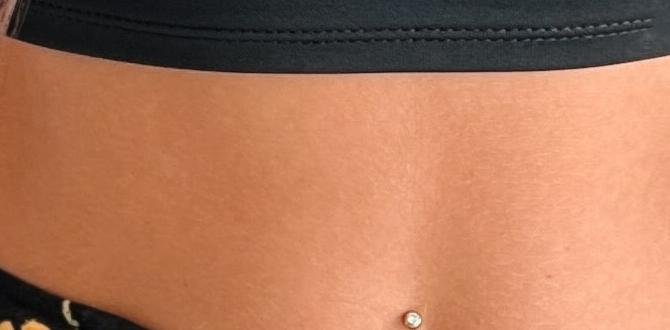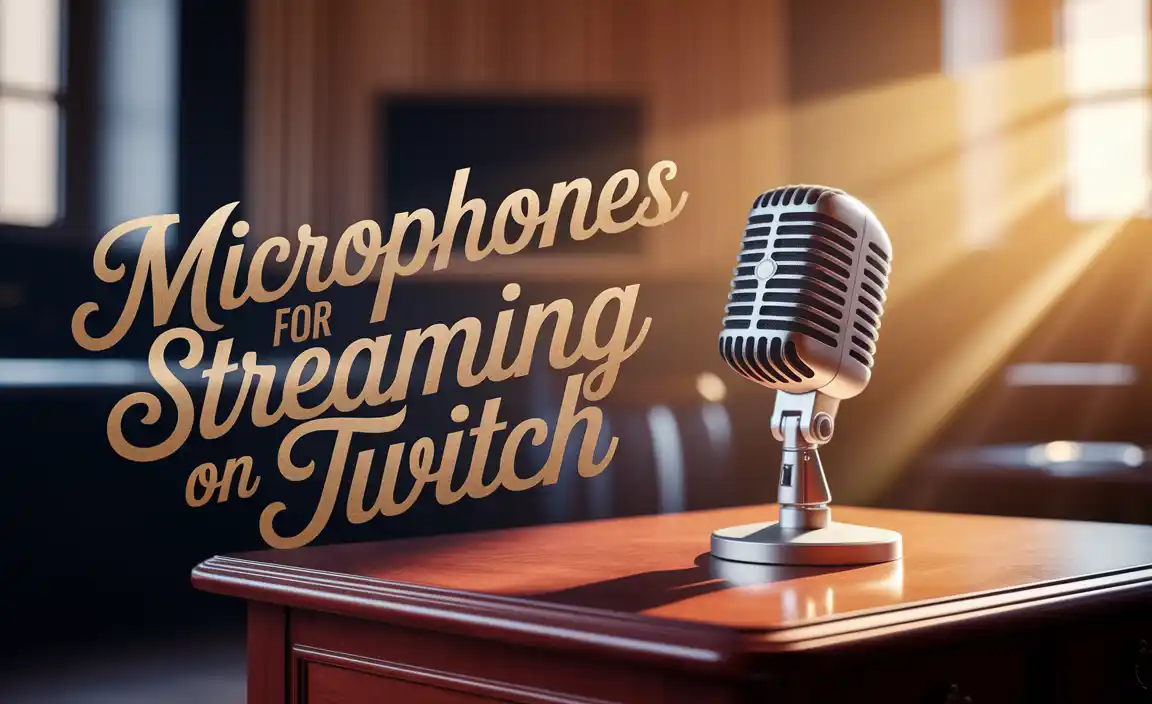Quick Summary: Tired of messy TV cables? This guide offers simple, proven solutions for TV stand cable management. Learn easy techniques and affordable products to hide wires, organize your entertainment center, and achieve a clean, polished look for your home theater setup.
Is your TV stand looking more like a spaghetti monster than a stylish entertainment hub? You’re not alone! Tangled cords from your TV, gaming consoles, streaming devices, and soundbars can quickly turn a neat living room into a chaotic mess. It’s frustrating, unsightly, and can even be a tripping hazard. But don’t worry! Getting your cables under control is easier than you think. We’ve gathered some super effective and beginner-friendly ways to transform that wire jungle into a clean, organized space.
Let’s dive into how you can finally conquer those annoying cables and make your TV area look fantastic!
Why Bother With TV Stand Cable Management?
Beyond just the aesthetic appeal of a tidy room, managing your TV cables offers several practical benefits:
- Improved Safety: Loose cables are trip hazards, especially for children and pets. Tucking them away reduces this risk significantly.
- Easier Maintenance: When cables are organized, it’s much simpler to troubleshoot issues, unplug devices, or add new equipment without creating a new mess.
- Enhanced Airflow: Cluttered cables can sometimes block ventilation ports on your electronics, leading to overheating. Proper management ensures devices can breathe.
- Professional Look: A clean entertainment center elevates the entire feel of your living space, making it more relaxing and enjoyable.
- Protection for Cords: Untidy cables can get bent, kinked, or damaged, potentially leading to performance issues or needing premature replacement.
Common Cable Culprits and Challenges
Before we tackle the solutions, let’s identify the usual suspects that contribute to cable chaos:
- Power Cords: Essential for every device, these are often the thickest and most numerous.
- HDMI Cables: Connecting your TV to streaming devices, game consoles, and Blu-ray players.
- Audio Cables: For soundbars, surround sound systems, or even connecting older devices.
- Ethernet Cables: For stable internet connections to smart TVs and gaming consoles.
- USB Cables: For powering devices or connecting peripherals.
- Power Strips/Surge Protectors: These devices themselves can become a tangled nest of cords.
The main challenges often involve having too many cords for too few outlets, cables that are too long, and the desire to hide them completely without drilling holes or making permanent changes.
Proven Solutions for TV Stand Cable Management
Here are some of the best and most popular ways to get your cables in order. We’ll cover simple DIY tricks and affordable accessories.
1. The Power of the Cable Tie
Cable ties are your first line of defense against unruly cords. They’re inexpensive and incredibly versatile.
Types of Cable Ties:
- Velcro Straps: These are fantastic because they are reusable and adjustable. You can easily add or remove cables. Many come in soft material that won’t damage your wires.
- Zip Ties/Cable Ties: These are permanent (or semi-permanent) solutions once tightened. They are very secure but require cutters to remove.
- Reusable Silicone Ties: Similar to Velcro, but often more durable and flexible, great for bundling oddly shaped cables.
How to Use Them:
- Gather the cables you want to bundle together.
- Lay them flat side-by-side.
- Wrap the cable tie around the bundle, snug but not so tight that it kinks the cables.
- Fasten the tie.
- Repeat for different sets of cables (e.g., bundle all power cords together, then bundle all HDMI cables together).
2. Cable Sleeves and Wraps
For a more consolidated and cleaner look, cable sleeves or wraps are a great option. They group multiple cables into one flexible tube.
Benefits of Cable Sleeves:
- Neat Appearance: They hide all the individual wires inside one sheath.
- Organization: Keeps related cables together.
- Protection: Adds a layer of protection against dust and damage.
Types of Sleeves:
- Neoprene Sleeves: These are flexible fabric sleeves, often with a zipper or Velcro opening, making them easy to install and adjust.
- Spiral Wraps: A plastic or rubber sleeve that wraps around the cables. You can add or remove cables by twisting the wrap.
- Braided Sleeving: This is a fabric sleeve that you “stuff” cables into. Once filled, it creates a clean, rounded bundle. Different colors are available to match your decor.
How to Use Them:
- Lay out your cables.
- If using a zipper or Velcro sleeve, open it completely.
- Place the cables inside or along the sleeve.
- Secure the sleeve by zipping it up or fastening the Velcro.
- If using a spiral wrap, simply wrap it around the bundled cables.
- If using braided sleeving, push cables into the opening.
3. Cable Raceways and Covers
If you need to run cables along walls or behind furniture, raceways are your best friend. They are hollow channels that conceal wires.
Why Use Raceways?
- Wall-Mounted Storage: Perfect for hiding cables that run from your TV to a wall outlet or media console.
- Clean Lines: They create a seamless look against your wall.
- Protection: Keeps cables safe from accidental pulls or damage.
Installation Basics:
Most cable raceways come with an adhesive backing, making them easy to stick to walls or baseboards. Some may require screws for a more permanent installation. You simply open the channel, place your cables inside, and close it.
Where to Buy:
You can find excellent cable raceways at most hardware stores or online retailers like Amazon. Look for brands like Legrand Wiremold or D-Line for quality options.
4. Cable Boxes and Organizers
These are specifically designed to hide power strips and their associated cords, often looking like discreet boxes or decorative containers.
Advantages of Cable Boxes:
- Hide Clutter: They effectively conceal power strips and all the messy plugs.
- Aesthetic Improvement: They can look like stylish decor pieces.
- Ventilation: Good designs ensure devices stay cool.
Key Features to Look For:
- Size: Ensure it’s large enough to fit your power strip and all its plugs.
- Ventilation Slots: Crucial for preventing overheating from the power strip and plugged-in devices.
- Cable Entry/Exit Points: Multiple slots allow you to neatly route power cords in and out.
- Child-Proofing: Some have lids that deter curious little fingers.
How They Work:
You simply place your power strip inside the box, plug your devices into it, and then route the power cord(s) from the power strip out through the designated slots. The box then hides the entire setup.
5. Adhesive Cable Clips and Holders
These small but mighty tools are perfect for managing individual cables, keeping them tidy and in place.
When to Use Cable Clips:
- Desk Sides: Attach a clip to the edge of your desk or TV stand to guide charging cables.
- Behind the TV: Stick them to the back of your TV stand to route HDMI or power cords neatly.
- Wall Management: Use them to hold cables along baseboards or up the wall.
Types Available:
- Single Cable Clips: Small, often plastic or silicone, with an adhesive back to hold one cable.
- Multi-Cable Holders: Designed to hold several cables in one unit.
- Desk Glands/Grommets: If your TV stand has a solid top or a compartment, a grommet can create a neat opening for cables to pass through.
A great resource for understanding cord management principles, including safety, can be found on sites like the U.S. Consumer Product Safety Commission (CPSC), which offers valuable insights on preventing electrical hazards.
6. Using Furniture Features
Your TV stand itself might have built-in solutions you’re overlooking.
Look For:
- Cable Pass-Through Holes: Many modern TV stands come with pre-drilled holes in the back panel or shelves to easily pass cables through.
- Ventilation Grills: These can sometimes double as a spot to tuck away smaller cables.
- Integrated Cable Management Systems: Some higher-end units have channels, clips, or even built-in raceways.
7. The Power of a Good Power Strip
Choosing the right power strip can make a big difference.
What to Consider:
- Number of Outlets: Make sure it has enough for all your devices, plus a few extra for the future.
- Surge Protection: Essential to protect your valuable electronics from power surges. Look for one that clearly states its joule rating for protection.
- Outlet Spacing: Some strips have widely spaced outlets, perfect for bulky adapters that might block adjacent ones.
- Mounting Options: Some power strips can be mounted to the back of a TV stand or wall, keeping them off the floor and tidier.
8. Longer or Shorter Cables
Sometimes, the problem is simply cables that are too long or too short.
- Too Long: Excessively long cables are a primary cause of clutter. Instead of coiling them tightly (which can damage them), use cable ties or sleeves to manage the slack neatly.
- Too Short: If cables are too short, you might be forced to stretch them or use extension cords, which adds to the mess. Consider purchasing appropriately sized cables for a cleaner run.
9. Cord Wraps for Specific Devices
For devices that are frequently moved or have their own distinct set of wires (like gaming controllers or charging bricks), dedicated cord wraps can be handy.
10. Planning Your Setup
Before you plug anything in, take a moment to plan. Think about where each device will go and how the cables will run from there to the power source and to each other.
Steps for Planning:
- Inventory: List all the devices and the cables they need.
- Placement: Decide where each device will sit on or inside your TV stand.
- Routing: Sketch out or visualize the path for each cable. Aim to keep them together and hidden.
- Power Source: Identify the nearest power outlet(s) and how cables will reach them.
DIY vs. Purchased Solutions: A Comparison
When it comes to managing your TV cables, a mix of DIY creativity and smart purchases often yields the best results. Here’s a quick look at the pros and cons:
| Solution Type | Pros | Cons |
|---|---|---|
| DIY (e.g., Rubber Bands, Toilet Paper Rolls) | Extremely low cost, quick fixes, readily available materials. | Can look messy if not done carefully, not very durable, might damage cables over time (e.g., tight rubber bands). |
| Cable Ties & Velcro Straps | Affordable, easy to use, reusable (Velcro), effective for bundling. | Can still be visible if not hidden, zip ties are single-use. |
| Cable Sleeves & Wraps | Neat appearance, consolidates multiple cables into one, good protection. | Requires purchasing the sleeve, can be a bit fiddly to get all cables in. |
| Cable Boxes & Organizers | Hides all the clutter, looks neat, can be decorative. | Can be more expensive, need to ensure proper ventilation. |
| Adhesive Clips & Raceways | Good for routing along walls/furniture, keeps individual cables tidy. | Adhesive might fail over time, requires careful placement, raceways can be visually prominent. |
Putting It All Together: A Step-by-Step Example
Let’s imagine a common setup: a TV, a soundbar, a gaming console, and a streaming stick, all connected and powered.
- Gather Supplies: You’ll want cable ties (Velcro is great here), a cable sleeve for the main power cords, and perhaps a cable box for the power strip.
- Position Devices: Place your TV, soundbar, console, and streaming stick in their desired spots on the stand.
- Connect Device Cables:
- Connect the HDMI cable from your console to the TV.
- Connect the HDMI cable from your streaming stick to the TV (or receiver).
- Connect the soundbar’s power cord and any audio cables (e.g., HDMI ARC).
- Connect the console’s power cord.
- Connect the streaming stick’s power (often a USB cable).
- Bundle Power Cords: Gather all the power cords (soundbar, console, streaming stick, and the TV’s power cord if it’s separate). Use Velcro ties to bundle these together neatly behind the devices.
- Manage the Power Strip:
- Place your power strip inside the cable box.
- Plug in the grouped power cords from your devices into the power strip.
- Route the single power cord from the power strip out of the cable box and towards the wall outlet.
- Conceal Remaining Cables: If there are still visible cables running from the TV or stand to the power strip or outlet, use a cable sleeve or strategically placed adhesive clips to keep them hidden. For instance, run the power cords from the TV and soundbar together down the back using a sleeve.
- Hide the Cable Box: Place the cable box at the back of the stand, tucking away the power strip and excess cord.
- Final Check: Ensure no cords are dangling precariously or creating a mess. Double-check for airflow.
FAQ: Your Cable Management Questions Answered
Q1: What’s the easiest way to hide cables behind my TV?
The easiest way is often using adhesive cable clips spaced out along the back of your TV stand or wall to guide the cables down neatly. For a more complete solution, a cable sleeve or a cable management box for your power strip works wonders.
Q2: Do I need a special TV stand for cable management?
Not necessarily! While some TV stands come with built-in cable management features like pass-through holes, you can effectively manage cables with any stand using accessories like cable ties, sleeves, and boxes.
Q3: How can I organize the wires from my soundbar and other audio equipment?
Bundle the power cord and any HDMI or optical cables with Velcro ties. You can then run this bundle neatly along the back of your TV stand, perhaps secured with adhesive clips, to keep them from dangling.
Q4: Can I run cables along my wall without drilling?
Yes! Cable raceways with strong adhesive backing are perfect for this. They stick to your wall or baseboard and hide the cables inside, offering a clean look without making permanent holes.
Q5: How do I deal with bulky power adapters?
Wide-spaced outlets on a power strip are your best bet. If using a cable box, ensure it’s large enough and has sufficient entry/exit points to accommodate these adapters without jamming everything together, which can hinder airflow.
Q6: What’s the difference between zip ties and Velcro cable ties?
Zip ties are a one-time use, permanent fix once tightened, requiring cutters to remove. Velcro cable ties are reusable, adjustable, and much easier to open and close, making them ideal for setups you might change often.
Q7: How much should I expect to spend on cable management solutions?
You can spend very little! Basic cable ties can cost under $10 for a large pack. Cable sleeves range from $10-$30 depending on size and material. Cable management boxes are typically $15-$40. You can achieve excellent results






